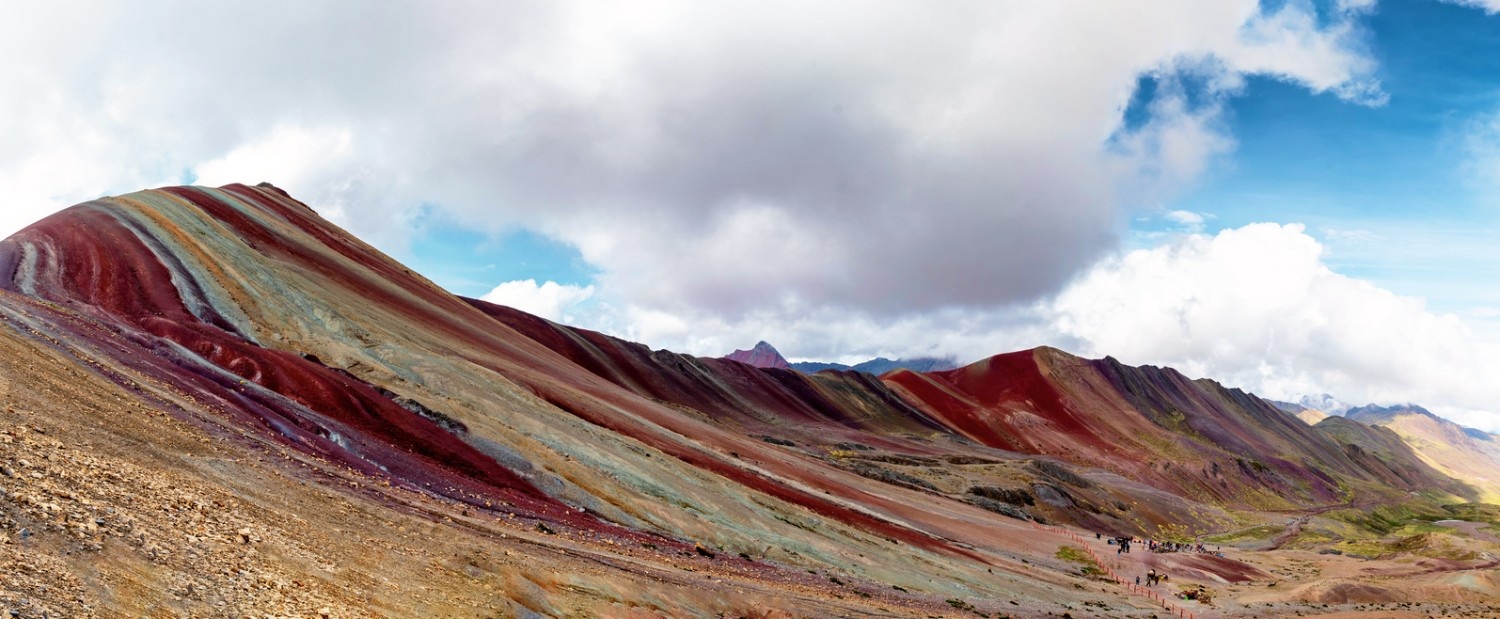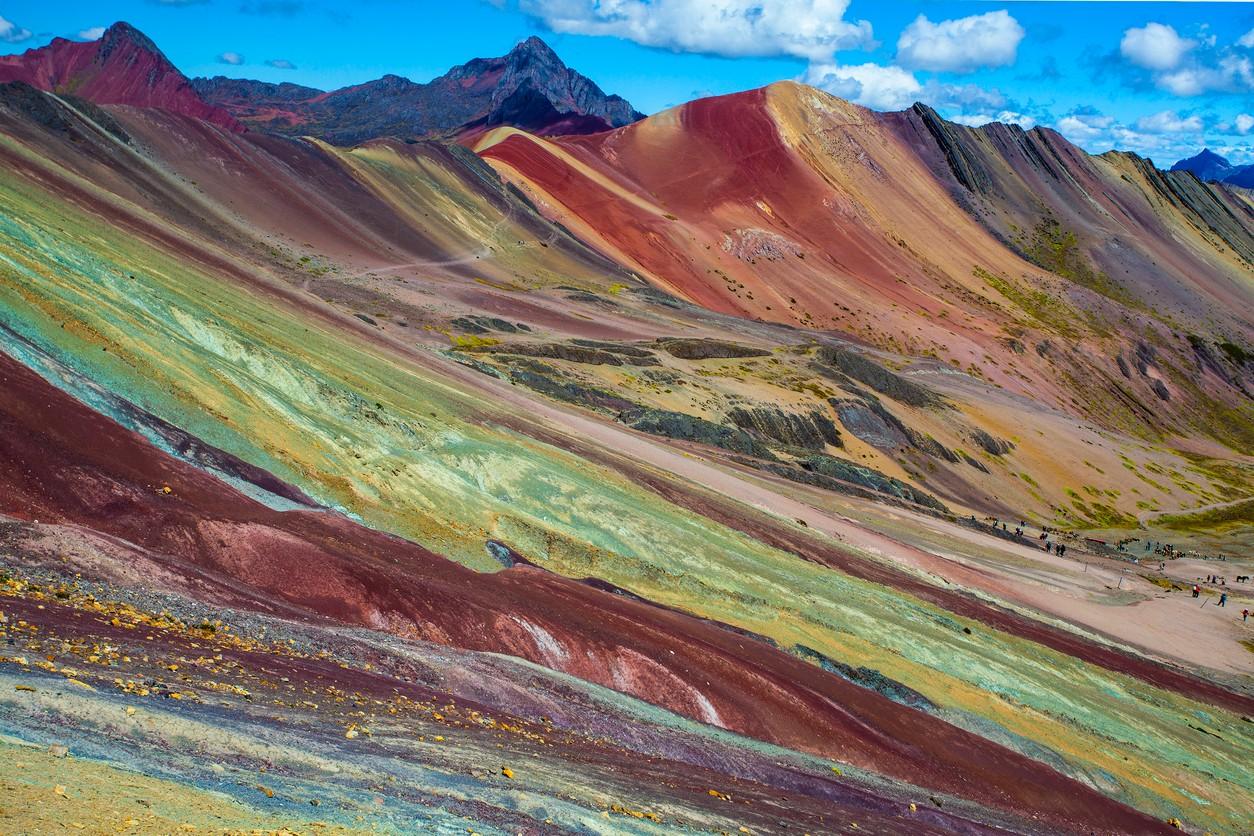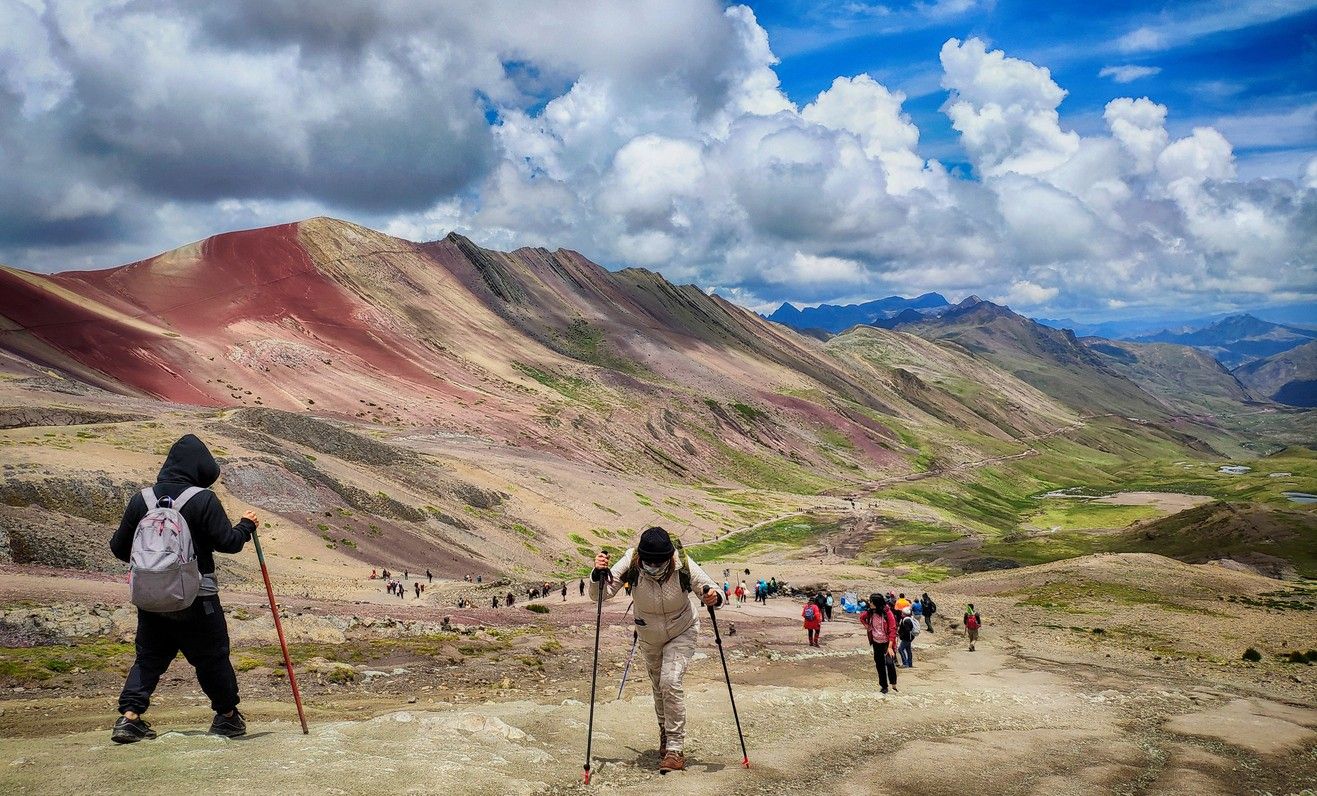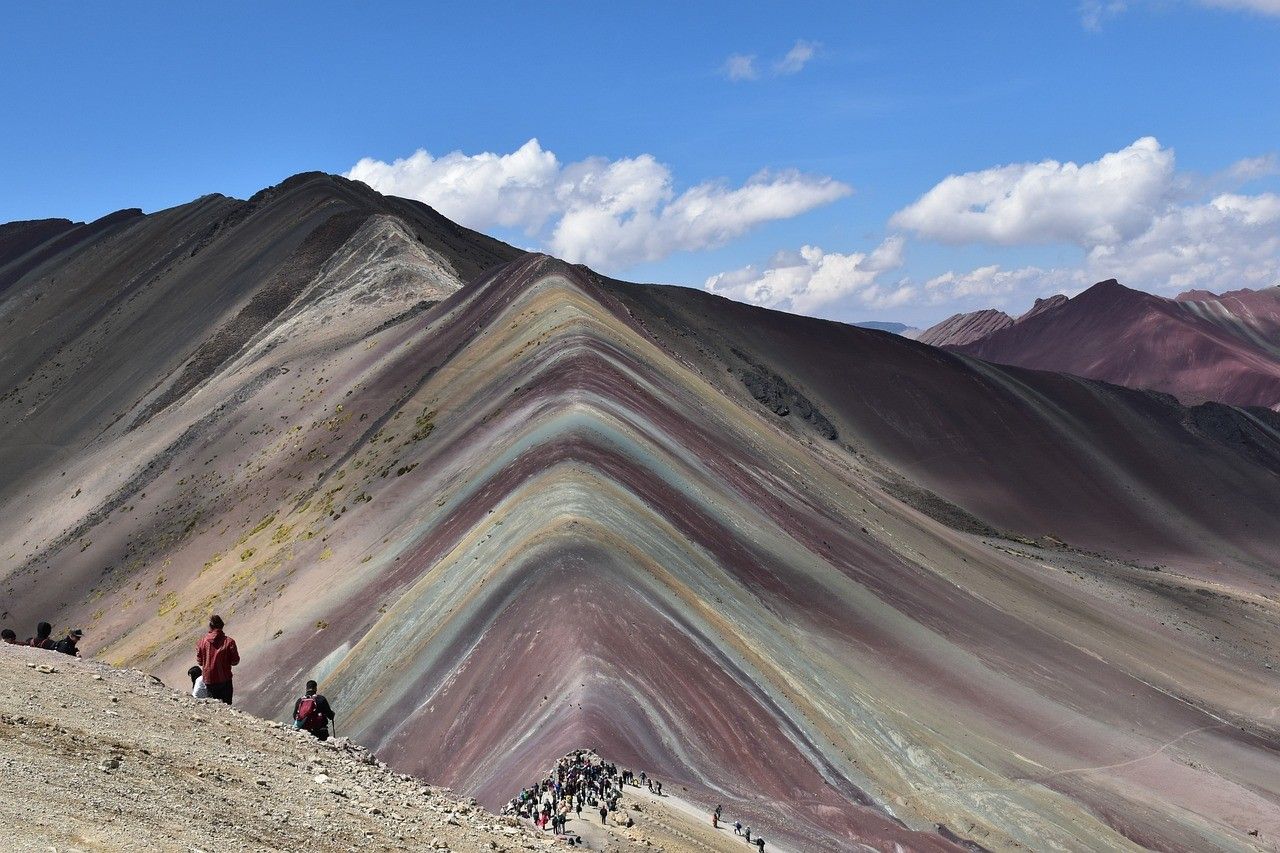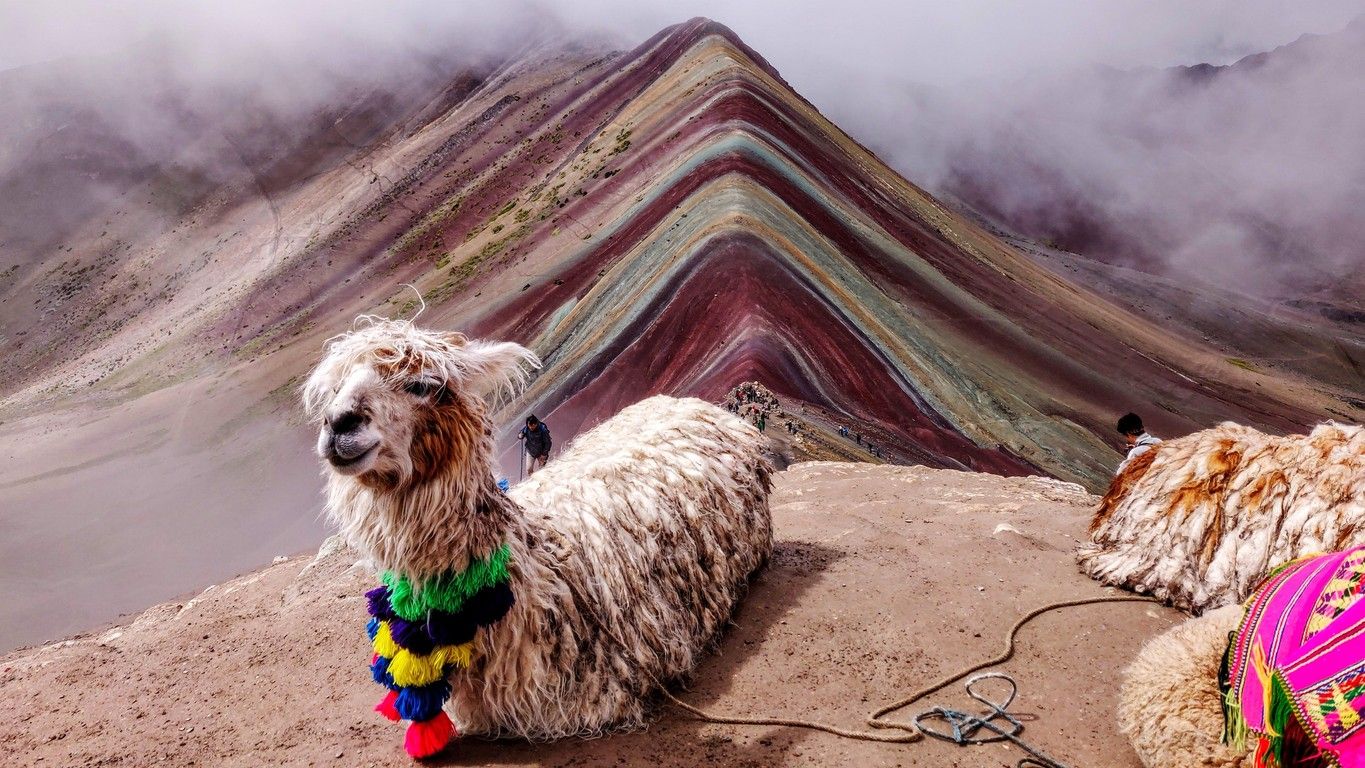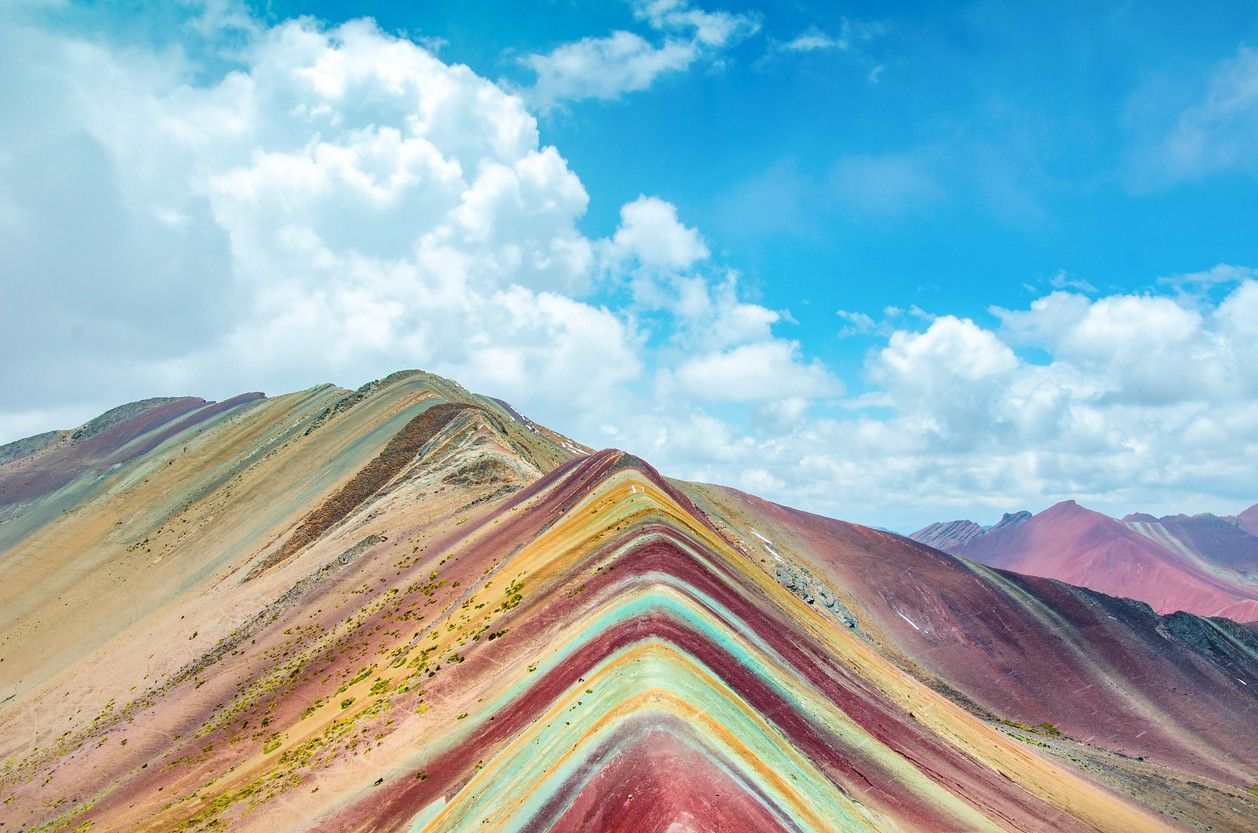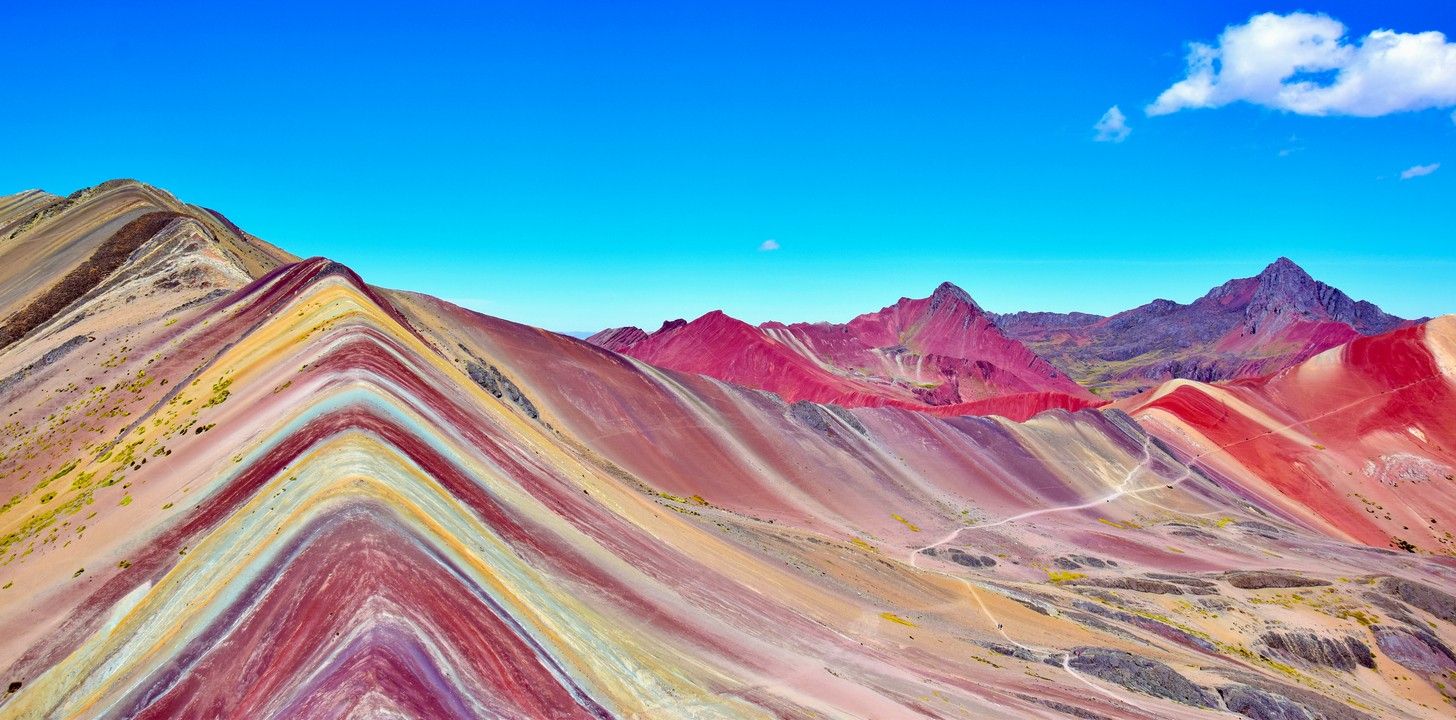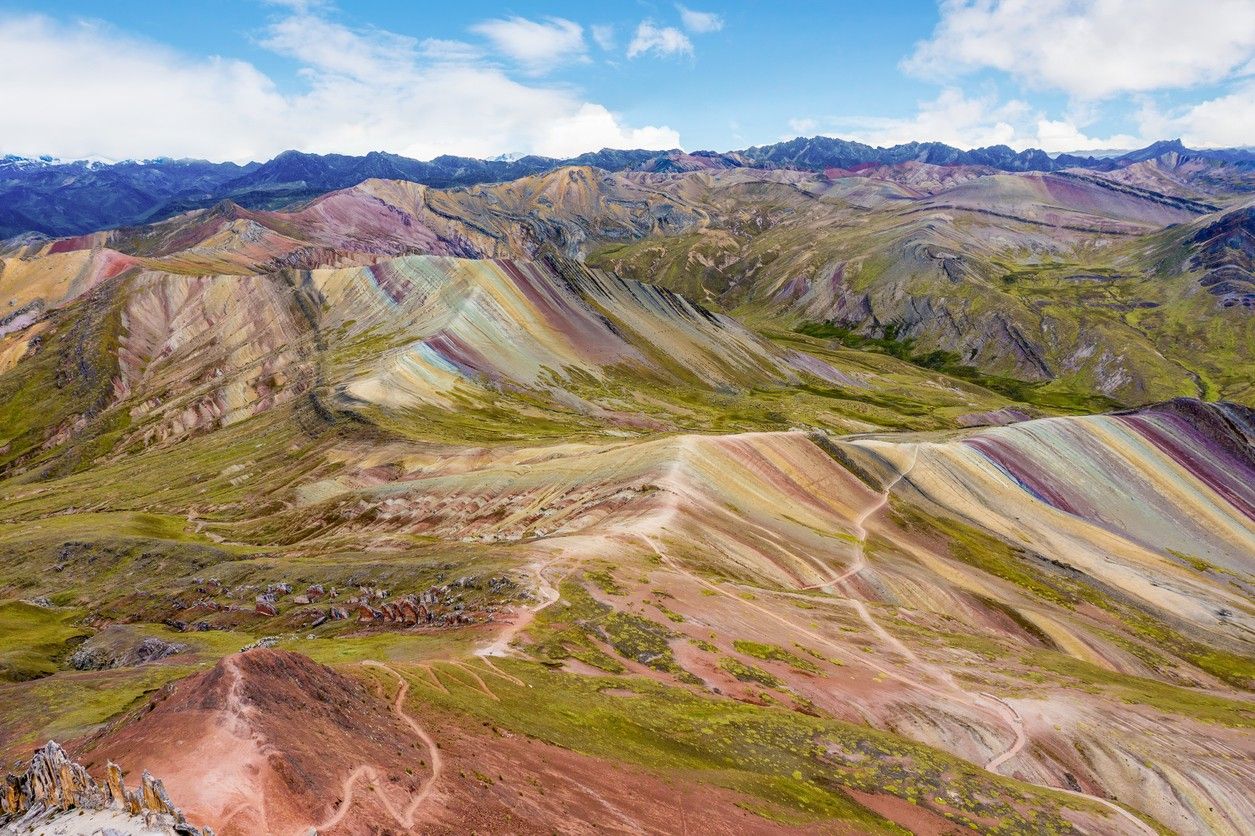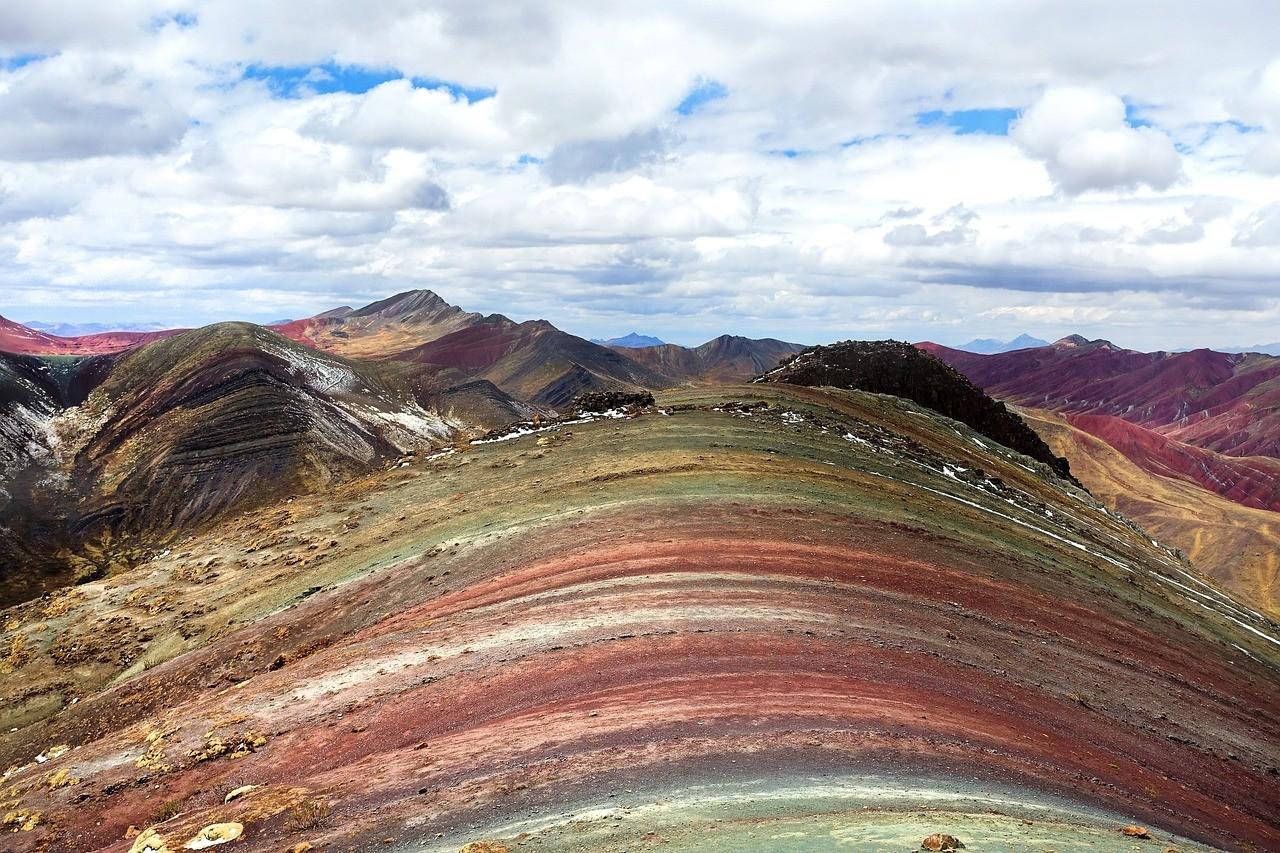The Rainbow Mountain, also known as Vinicunca or Montaña de Siete Colores (Mountain of Seven Colors), is a breathtaking natural wonder located in the Peruvian Andes. This stunning geological formation has captured the hearts of travellers and nature enthusiasts from around the world, thanks to its vibrant colours and incredible landscapes. The Rainbow Mountain is a testament to the incredible diversity and beauty of the Earth's natural wonders, and is situated in the Cusco region of Peru, approximately 100 kilometres southeast of the city of Cusco. The mountain range is part of the larger Vilcanota mountain range, which is home to several other stunning peaks and glaciers. The Rainbow Mountain is located at an altitude of 5,200 meters above sea level, making it one of the highest accessible mountain ranges in the world.
The journey to the Rainbow Mountain is an adventure in itself, taking visitors through some of the most remote and stunning landscapes in the Peruvian Andes. The trek typically starts from the village of Pitumarca, which is located about a three-hour drive from Cusco. From there, visitors embark on a challenging but rewarding hike through the Andean wilderness, passing by glacial lakes, snow-capped peaks, and herds of llamas and alpacas grazing on the hillsides. The Rainbow Mountain has only recently gained international attention, thanks in part to the rise of social media and the increasing popularity of adventure travel. Before the 2010s, the mountain range was relatively unknown outside of the local communities, who have long revered the site as a sacred place. Today, the Rainbow Mountain attracts thousands of visitors each year, drawn by the promise of stunning views and a unique cultural experience.
The Formation of the Rainbow Mountain
The Rainbow Mountain is the result of millions of years of geological processes, which have created a unique and stunning landscape unlike anything else on Earth. The mountain's distinctive colouration is the result of different mineral deposits that have been laid down over time, each with its unique hue. The formation of the Rainbow Mountain began around 25 million years ago, during the Paleogene period. At this time, the Andes mountain range was still forming, as the Nazca tectonic plate subducted beneath the South American plate. This process caused the uplift of the Andes, creating the towering peaks and deep valleys that characterise the range today. As the mountain was forming, various mineral deposits were laid down in layers, creating the distinctive stripes of colour that we see today. The red layers are caused by iron oxide rust, while the yellow and orange hues are the result of iron sulfide. The green layers are rich in chlorite, a mineral that is commonly found in metamorphic rocks. The purple layers are composed of goethite or oxidised limonite, which are both iron-bearing minerals.
Over time, these mineral layers were exposed to erosion, as wind and water slowly wore away the overlying rock. The result is a stunning display of colour, with each layer representing a different chapter in the geological history of the region. The Rainbow Mountain is not the only example of this type of geological formation in the world, but they are certainly one of the most spectacular. Similar formations can be found in China's Zhangye Danxia National Geological Park and the Painted Hills of Oregon, USA. However, the Rainbow Mountain of Peru is unique in their scale and accessibility, making them a true wonder of the natural world.
The Cultural Significance of Vinicunca
In addition to its geological significance, the Rainbow Mountain holds a special place in Peruvian culture and history. The mountain is considered a sacred site by the local Quechua people, who have lived in the region for centuries. The Quechua people are the descendants of the Inca civilisation, which once ruled over a vast empire that stretched from modern-day Colombia to Chile. The Inca were known for their advanced engineering and agricultural techniques, as well as their rich cultural traditions and spiritual beliefs. According to Quechua beliefs, the Rainbow Mountain is home to the deity Apu, who is believed to protect the local communities and their livestock. Apu is considered a powerful and benevolent spirit, who watches over the people and ensures their well-being.
The Quechua people perform traditional ceremonies and offerings at Rainbow Mountain to honour Apu and seek his blessings. These ceremonies often involve the use of coca leaves, which are considered sacred and are used in many Andean spiritual practices. The coca leaf is a mild stimulant that has been used by Andean people for thousands of years. It is often chewed or brewed into tea and is believed to provide energy and alleviate the symptoms of altitude sickness. The use of coca leaves is deeply ingrained in the Andean culture and is seen as a way of connecting with the spirit world and honouring the ancestors. The Rainbow Mountain is also an important cultural landmark for the Quechua people. The mountain is often depicted in traditional Andean art and textiles and is seen as a symbol of the region's rich cultural heritage. Today, many Quechua communities continue to live in the shadow of the Rainbow Mountain, maintaining their traditional way of life and cultural practices. Visitors to the region have the opportunity to learn about these communities and their unique cultural heritage, providing a deeper understanding and appreciation of the significance of this incredible natural wonder.
Exploring the Rainbow Mountain in Peru
Visiting the Rainbow Mountain is an unforgettable experience that offers visitors the chance to immerse themselves in the stunning natural beauty of the Peruvian Andes. The journey to the mountain is an adventure in itself, taking visitors through picturesque landscapes and remote villages.
Getting to the Mountain
The Rainbow Mountain is located in the Cusco region of Peru, approximately 100 kilometres southeast of the city of Cusco. The most common starting point for the trek to the mountain is the village of Pitumarca, which can be reached by a three-hour drive from Cusco. Visitors can reach Pitumarca by private car or by taking a public bus from Cusco. The drive to Pitumarca is an adventure in itself, taking visitors through stunning Andean landscapes and remote villages. Along the way, visitors can catch glimpses of traditional Quechua communities, with their colourful textiles and unique way of life.
Once in Pitumarca, visitors can either choose to hike to the Rainbow Mountain independently or join a guided tour. Independent hiking is possible, but it is recommended only for experienced hikers who are well-acclimatised to the high altitude and have a good sense of direction. Guided tours are a popular option for visitors who want a more structured and supported trekking experience. These tours typically include transportation from Cusco, a knowledgeable guide, and sometimes even meals and camping equipment.
Trekking to the Mountain
The trek to the Rainbow Mountain is considered moderately difficult, with an elevation gain of approximately 1,000 meters. The trail starts at an altitude of around 4,300 meters and reaches a maximum elevation of 5,200 meters at the summit of the mountain. The trek typically takes between 3 to 4 hours to complete, depending on the individual's fitness level and acclimatisation to the high altitude. The trail winds through stunning Andean landscapes, passing by glacial lakes, snow-capped peaks, and herds of llamas and alpacas grazing on the hillsides. Along the way, visitors will have the opportunity to take in the incredible views of the surrounding mountains and valleys. The trail is well-marked and relatively easy to follow, but it can be challenging at times due to the high altitude and steep inclines.
Visitors should be prepared for variable weather conditions, as the mountain can experience sudden changes in temperature and precipitation. It is recommended to wear layers of warm, waterproof clothing and sturdy hiking boots with good traction. It is also important to stay hydrated and take frequent breaks to rest and acclimatise to the high altitude. Altitude sickness is a serious concern when trekking at high elevations, and visitors should be aware of the symptoms and take appropriate precautions.
Guided Tours & Trekking Options
For those who prefer a more structured and supported trekking experience, there are several guided tour options available. These tours typically include transportation from Cusco, a knowledgeable guide, and sometimes even meals and camping equipment. Guided tours can range from one-day treks to multi-day expeditions, depending on the visitor's preferences and time constraints. One-day treks are the most popular option, allowing visitors to experience the Rainbow Mountain in a single-day trip from Cusco.
One-day treks typically start early in the morning, with visitors being picked up from their hotel in Cusco and driven to the starting point of the trek. The trek itself takes around 3 to 4 hours to complete, with plenty of time for rest stops and photo opportunities along the way. After reaching the summit of the Rainbow Mountain, visitors will have time to take in the incredible views and snap some photos before beginning the descent back down to the starting point. The entire day trip typically takes around 12 to 14 hours, depending on the specific tour and the fitness level of the group.
Multi-day treks, on the other hand, offer a more immersive experience, allowing visitors to explore the surrounding landscapes and communities at a slower pace. These treks often include overnight stays in local villages or campsites, providing a unique opportunity to connect with the local culture and way of life. Multi-day treks can range from 2 to 5 days, depending on the specific itinerary and the preferences of the group. These treks often include visits to other stunning natural wonders in the region, such as the Red Valley or the Ausangate Mountain.
Regardless of the type of trek chosen, visitors can expect to be accompanied by a knowledgeable and experienced guide who can provide insight into the local culture, history, and ecology of the region. Guides are also trained in first aid and can assist visitors in case of any emergencies or altitude-related issues. When choosing a guided tour or trekking option, it is important to do your research and choose a reputable company with experienced guides and a good safety record. It is also important to ensure that the tour company is committed to sustainable and responsible tourism practices, to minimise the impact on the local environment and communities
The Stunning Landscapes in the Peruvian Andes
The Rainbow Mountain is just one of the many stunning landscapes that visitors can experience in the Peruvian Andes. The surrounding region is home to a diverse array of ecosystems, from high-altitude grasslands to glacial lakes and snow-capped peaks.
The Ausangate Mountain Range
The Ausangate Mountain Range is a stunning natural wonder in the Peruvian Andes's heart. This majestic range is home to the Ausangate Mountain, which stands at an impressive 6,384 meters above sea level, making it the highest peak in the Cusco region. The mountain is considered a sacred site by the local Quechua people, who have lived in the area for centuries and have a deep spiritual connection to the land. The Ausangate Trek is a popular multi-day hiking route that takes adventurers through some of the most breathtaking landscapes in the region. The trek typically takes 5 to 6 days to complete and covers a distance of approximately 70 kilometres. Along the way, hikers will pass through diverse ecosystems, from lush green valleys to high-altitude plains and glacial lakes. One of the highlights of the Ausangate Trek is the opportunity to see the stunning Vinicunca Mountain, also known as the Rainbow Mountain. This incredible geological formation is characterised by its vibrant stripes of colour, which are the result of mineral deposits in the rock. The colours range from deep reds and purples to bright yellows and greens, creating a truly mesmerising sight.
The Ausangate Mountain Range is home to several other natural wonders. The trek passes by hot springs, which offer a welcome respite for weary hikers and glacial lakes that reflect the stunning blue sky above. The area is also home to a variety of wildlife, including llamas, alpacas, and the elusive Andean condor. The Ausangate Trek is not for the faint of heart, as it involves long days of hiking at high altitudes. However, those who embark on this incredible journey will be rewarded with some of the most stunning views in the world. The trek offers a unique opportunity to immerse oneself in the natural beauty of the Andes and to connect with the rich cultural heritage of the Quechua people.
The Red Valley
The Red Valley, located just a short distance from the Rainbow Mountain, is a hidden gem in the Peruvian Andes. This stunning landscape is characterised by its vibrant red soil, which is the result of iron oxide deposits in the area. The valley is surrounded by towering red cliffs and rock formations that create a truly otherworldly atmosphere. Hiking through the Red Valley is a unique and unforgettable experience. The trail winds through a series of narrow canyons and passes by several small lakes and streams. The red soil beneath your feet creates a striking contrast against the blue sky above, and the silence of the valley is broken only by the occasional gust of wind or the distant call of a bird. One of the most impressive features of the Red Valley is the Nevado del Inca, a massive red rock formation that towers over the landscape. This incredible natural sculpture is a testament to the power of nature and the incredible geological processes that have shaped the Andes over millions of years. The Red Valley is also home to a rich cultural heritage. The area has been inhabited by the Quechua people for centuries, and visitors can still see evidence of their ancient agricultural practices in the form of terraced fields and stone walls. Hiking through the Red Valley is a moderate to challenging trek, depending on the route taken. The trail can be steep and rocky in places, and the high altitude can make the hike more difficult for some. However, those who persevere will be rewarded with incredible views and a sense of accomplishment that comes from immersing oneself in such a unique and beautiful landscape.
The Palccoyo Rainbow Mountain
The Palccoyo Rainbow Mountain is a lesser-known but equally stunning alternative to the famous Vinicunca Rainbow Mountain. Located just a short distance from its more famous counterpart, the Palccoyo Rainbow Mountain offers visitors the chance to experience the incredible beauty of the Andes without the crowds. The Palccoyo Rainbow Mountain is characterised by its colourful stripes of red, yellow, and green, which are the result of mineral deposits in the rock. The colours are not as vivid as those of the Vinicunca Rainbow Mountain, but they are still incredibly impressive and create a stunning contrast against the surrounding landscape. One of the advantages of visiting the Palccoyo Rainbow Mountain is that it is located at a lower altitude than the Vinicunca Rainbow Mountain, making it a more accessible option for those who may be concerned about the effects of high altitude. The trek to the Palccoyo Rainbow Mountain is also shorter and less strenuous than the trek to the Vinicunca Rainbow Mountain, making it a good option for those with limited time or fitness.
Despite its relative accessibility, the Palccoyo Rainbow Mountain still offers visitors an incredible opportunity to immerse themselves in the natural beauty of the Andes. The trail to the mountain passes through stunning landscapes of rolling hills and snow-capped peaks, and the views from the top are truly breathtaking. The Palccoyo Rainbow Mountain is also home to a rich cultural heritage. The area has been inhabited by the Quechua people for centuries, and visitors can still see evidence of their traditional way of life in the form of small villages and agricultural practices. Visiting the Palccoyo Rainbow Mountain is a unique and unforgettable experience that offers visitors the chance to connect with both the natural and cultural wonders of the Andes. Whether you are an experienced hiker or a first-time visitor to the region, the Palccoyo Rainbow Mountain is a must-see destination that is sure to leave a lasting impression.
Preparing for Your Visit to the Peruvian Rainbow Mountain
Visiting the Rainbow Mountains is an incredible experience, but it does require some preparation and planning. Here are some tips to help you make the most of your visit
Acclimatisation and Altitude Sickness
One of the most important things to keep in mind when visiting the Rainbow Mountains is the high altitude. The mountain is located at an elevation of over 5,000 meters, which can cause altitude sickness in some visitors. Altitude sickness is a serious condition that can occur when the body is exposed to high altitudes without proper acclimatisation. Symptoms can include headache, nausea, dizziness, fatigue, and shortness of breath. To minimise the risk of altitude sickness, it is important to acclimatise properly before attempting the trek. This means spending a few days in Cusco or another high-altitude location before embarking on the trek. During the acclimatisation period, it is important to take it easy and avoid strenuous activity. Drinking plenty of water and avoiding alcohol and caffeine can also help the body adjust to the high altitude. If you do experience symptoms of altitude sickness during the trek, it is important to take them seriously and descend to a lower altitude if necessary. In severe cases, altitude sickness can be life-threatening, so it is important to seek medical attention if symptoms persist or worsen.
What to Pack
When packing for your visit to the Rainbow Mountains, it is important to bring warm, waterproof clothing and sturdy hiking boots. The weather can be unpredictable at high altitudes, so it is best to be prepared for any conditions. Layering is key when it comes to clothing for the trek. A base layer of moisture-wicking material can help keep you dry and comfortable, while a mid-layer of fleece or wool can provide insulation. A waterproof outer layer is also essential, as rain and snow are common in the Andes.
Other essential items to pack include:
- Sunscreen and a hat to protect against the strong UV rays at high altitudes
- Sunglasses to protect your eyes from the bright sun and glare off the snow
- A reusable water bottle and snacks to keep you hydrated and energised during the trek
- A camera to capture the stunning views
- Cash for any purchases or tips along the way
- A small first-aid kit with basic supplies such as bandages, pain relievers, and altitude sickness medication
- It is also a good idea to bring a small daypack to carry these essentials during the trek, as well as any additional layers or gear you may need.
Related Articles

Let us know you agree to cookies
We use marketing, analytical and functional cookies as well as similar technologies to give you the best experience. Third parties, including social media platforms, often place tracking cookies on our site to show you personalised adverts outside of our website.
We store your cookie preferences for two years and you can edit your preferences via ‘manage cookies’ or through the cookie policy at the bottom of every page. For more information, please see our cookie policy.
